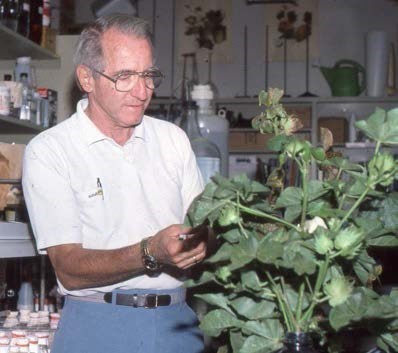
James Edson DeVay
Professor of Plant Pathology, Emeritus
James Edson DeVay, Professor Emeritus of Plant Pathology at the University of California, Davis, passed away on December 4, 2014. Jim was born on November 23, 1921, to Sarah Edson and James Harry DeVay in Minneapolis. He joined the Navy during World War II, and served as a pilot and flight instructor. As a returning veteran, he attended the University of Minnesota, receiving his bachelor's degree in 1949 and his Ph.D. in Plant Pathology in 1953. His doctoral research was mentored by E.C. Stakman and John B. Rowell, where he conducted biochemical studies of sex and pathogenicity in Ustilago zeae.
After a brief postdoctoral appointment, Jim joined the faculty in the Department of Plant Pathology, University of Minnesota, as an Assistant Professor in 1954 and Associate Professor in 1957. That same year, he accepted an opportunity to join the faculty in the Department of Plant Pathology, University of California, Davis, where he was promoted to Professor of Plant Pathology in 1965. During his distinguished 35-year career at UC Davis, Jim was chairman of the plant pathology department and served as an associate dean in the Division of Biological Sciences. He was active on many committees over the years, recognizing the critical importance of faculty service in the shared governance of an institution. He taught at Trinity and University College Dublin in Ireland while on sabbatical. Jim received a number of honors during his career, including APS Fellow in 1972 and the E.C. Stakman Award in 2001.
Jim DeVay was internationally recognized and respected for his research on plant- pathogen interactions, where early on he recognized the importance of knowledge of sequential interactions of host and pathogen and applied modern biochemical techniques to the study of host-parasite physiology. He researched a variety of pathosystems throughout the course of his career, and often at multiple levels of inquiry that included basic studies of the plant-microbe interaction to applied aspects of epidemiology and disease management. Jim and his many students, postdoctoral associates, technical staff and faculty collaborators also worked closely with growers in the field, providing information on etiology and control. His early research at UC Davis focused on fungal and bacterial diseases of orchard crops, particularly bacterial canker of stone fruits, Ceratocystis canker of almond and prune, and hull rot of almond. The pioneering research of Jim and his group on Pseudomonas syringae led to a number of seminal discoveries, including isolation and characterization of the phytotoxin syringomycin, as well as uncovering aspects of the etiology of bacterial canker disease. Syringomycin became a model in bacterial phytotoxin research and one of the best documented cases at the time of a toxin of pathogen origin playing a primary role in the killing of host tissue. In later years, he worked on the etiology, epidemiology and management of diseases of cotton, particularly fungal seedling diseases and Verticillium and Fusarium wilts. This research resulted in many seed treatment studies as well as exploration of alternative control strategies for wilt diseases, such as biological control. Jim was among the first investigators to rigorously evaluate solarization for management of soilborne diseases in cotton and other crops in California. A perusal of his publications reveals the remarkable diversity of his research interests and significant contributions to plant pathology.
Jim's research studies were an integral part of his teaching. For many years he co-taught courses on fungal physiology and the physiology of host-parasite interactions, and later he brought his wealth of experience and knowledge to teaching introductory plant pathology. Colleagues who had the privilege of teaching with him and students in his classes were enriched by his enthusiasm and his historical knowledge of physiological plant pathology that was both crucial and critical because he was a big part of it. His personal anecdotes and relationship with the players of the day in biochemistry of disease made the literature come alive at a time when missing one of his lectures for the students meant missing a whole lot more than chalk dust or what was in his notes.
Jim was active in APS, serving as chair of the Disease and Pathogen Physiology Committee (an early precursor to the Molecular and Cellular Phytopathology Committee), as Associate Editor of Phytopathology, and on other committees. He was also on the editorial board of Physiological Plant Pathology. He was a frequent speaker at international meetings, including the First International Congress of Plant Pathology and the U.S.-Japan Joint Science Seminar series, and was on the organizing committee for the Second International Congress of Plant Pathology. He was often invited as a seminar speaker and lecturer in short courses in plant pathology on campuses throughout the country.
For more than 80 years, Jim bred and raised racing pigeons. His champion birds won many races and he made many wonderful friends who shared his enthusiasm for the sport. He served for many years as the treasurer of the Sacramento Valley Racing Pigeon Club. Jim had other pursuits as well, including a sheep project, which for a time rivaled his pigeon breeding and racing. Here, too, it was all about breeding for superior bloodlines, which he took quite seriously and in the name of improvement.
Jim retired from UC Davis in 1992 and continued to remain active and drop by the department for many years. Upon learning the news of his death, there was an almost immediate response from many of his colleagues in the department who shared remembrances by email. Perhaps the word that resonated most throughout these messages was "kind". And that he was. Jim was predeceased by his beloved wife of 67 years, Mary Alice DeVay, who passed away in September 2014, and a granddaughter. Besides his family – six children, 15 grandchildren, 12 great-grandchildren, and his sister and brother – he left behind many students and colleagues who fondly remember his great academic gifts to them and who join the family in grief at his loss.
Richard Bostock
John Andrews
David Gilchrist
Joseph Wakeman
